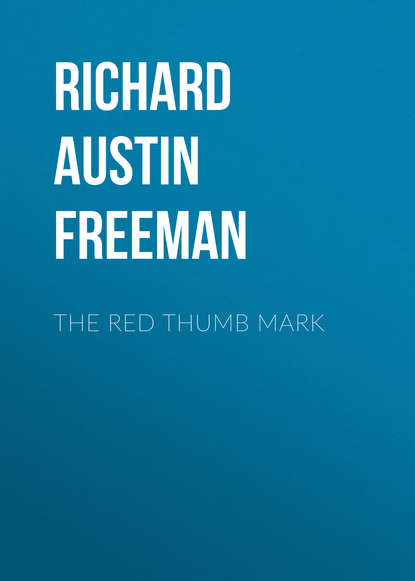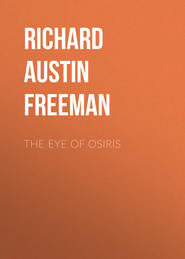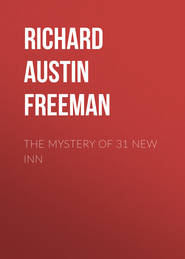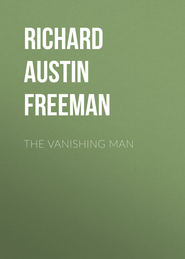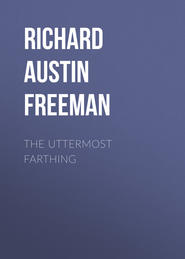По всем вопросам обращайтесь на: info@litportal.ru
(©) 2003-2024.
✖
The Red Thumb Mark
Настройки чтения
Размер шрифта
Высота строк
Поля
"Have you given any attention to the subject of finger-prints?"
"Yes. A great deal of attention."
"Be good enough to examine that paper" (here the usher handed to Thorndyke the memorandum slip). "Have you seen it before?"
"Yes. I saw it at Scotland Yard."
"Did you examine it thoroughly?"
"Very thoroughly. The police officials gave me every facility and, with their permission, I took several photographs of it."
"There is a mark on that paper resembling the print of a human thumb?"
"There is."
"You have heard two expert witnesses swear that that mark was made by the left thumb of the prisoner, Reuben Hornby?"
"I have."
"Do you agree to that statement?"
"I do not."
"In your opinion, was the mark upon that paper made by the thumb of the prisoner?"
"No. I am convinced that it was not made by the thumb of Reuben Hornby."
"Do you think that it was made by the thumb of some other person?"
"No. I am of opinion that it was not made by a human thumb at all."
At this statement the judge paused for a moment, pen in hand, and stared at Thorndyke with his mouth slightly open, while the two experts looked at one another with raised eyebrows.
"By what means do you consider that the mark was produced?"
"By means of a stamp, either of indiarubber or, more probably, of chromicized gelatine."
Here Polton, who had been, by degrees, rising to an erect posture, smote his thigh a resounding thwack and chuckled aloud, a proceeding that caused all eyes, including those of the judge, to be turned on him.
"If that noise is repeated," said the judge, with a stony stare at the horrified offender—who had shrunk into the very smallest space that I have ever seen a human being occupy—"I shall cause the person who made it to be removed from the court."
"I understand, then," pursued Anstey, "that you consider the thumb-print, which has been sworn to as the prisoner's, to be a forgery?"
"Yes. It is a forgery."
"But is it possible to forge a thumb-print or a finger-print?"
"It is not only possible, but quite easy to do."
"As easy as to forge a signature, for instance?"
"Much more so, and infinitely more secure. A signature, being written with a pen, requires that the forgery should also be written with a pen, a process demanding very special skill and, after all, never resulting in an absolute facsimile. But a finger-print is a stamped impression—the finger-tip being the stamp; and it is only necessary to obtain a stamp identical in character with the finger-tip, in order to produce an impression which is an absolute facsimile, in every respect, of the original, and totally indistinguishable from it."
"Would there be no means at all of detecting the difference between a forged finger-print and the genuine original?"
"None whatever; for the reason that there would be no difference to detect."
"But you have stated, quite positively, that the thumb-print on this paper is a forgery. Now, if the forged print is indistinguishable from the original, how are you able to be certain that this particular print is a forgery?"
"I was speaking of what is possible with due care, but, obviously, a forger might, through inadvertence, fail to produce an absolute facsimile and then detection would be possible. That is what has happened in the present case. The forged print is not an absolute facsimile of the true print. There is a slight discrepancy. But, in addition to this, the paper bears intrinsic evidence that the thumb-print on it is a forgery."
"We will consider that evidence presently, Dr. Thorndyke. To return to the possibility of forging a finger-print, can you explain to us, without being too technical, by what methods it would be possible to produce such a stamp as you have referred to?"
"There are two principal methods that suggest themselves to me. The first, which is rather crude though easy to carry out, consists in taking an actual cast of the end of the finger. A mould would be made by pressing the finger into some plastic material, such as fine modelling clay or hot sealing wax, and then, by pouring a warm solution of gelatine into the mould, and allowing it to cool and solidify, a cast would be produced which would yield very perfect finger-prints. But this method would, as a rule, be useless for the purpose of the forger, as it could not, ordinarily, be carried out without the knowledge of the victim; though in the case of dead bodies and persons asleep or unconscious or under an anaesthetic, it could be practised with success, and would offer the advantage of requiring practically no technical skill or knowledge and no special appliances. The second method, which is much more efficient, and is the one, I have no doubt, that has been used in the present instance, requires more knowledge and skill.
"In the first place it is necessary to obtain possession of, or access to, a genuine finger-print. Of this finger-print a photograph is taken, or rather, a photographic negative, which for this purpose requires to be taken on a reversed plate, and the negative is put into a special printing frame, with a plate of gelatine which has been treated with potassium bichromate, and the frame is exposed to light.
"Now gelatine treated in this way—chromicized gelatine, as it is called—has a very peculiar property. Ordinary gelatine, as is well known, is easily dissolved in hot water, and chromicized gelatine is also soluble in hot water as long as it is not exposed to light; but on being exposed to light, it undergoes a change and is no longer capable of being dissolved in hot water. Now the plate of chromicized gelatine under the negative is protected from the light by the opaque parts of the negative, whereas the light passes freely through the transparent parts; but the transparent parts of the negative correspond to the black marks on the finger-print, and these correspond to the ridges on the finger. Hence it follows that the gelatine plate is acted upon by light only on the parts corresponding to the ridges; and in these parts the gelatine is rendered insoluble, while all the rest of the gelatine is soluble. The gelatine plate, which is cemented to a thin plate of metal for support, is now carefully washed with hot water, by which the soluble part of the gelatine is dissolved away leaving the insoluble part (corresponding to the ridges) standing up from the surface. Thus there is produced a facsimile in relief of the finger-print having actual ridges and furrows identical in character with the ridges and furrows of the finger-tip. If an inked roller is passed over this relief, or if the relief is pressed lightly on an inked slab, and then pressed on a sheet of paper, a finger-print will be produced which will be absolutely identical with the original, even to the little white spots which mark the orifices of the sweat glands. It will be impossible to discover any difference between the real finger-print and the counterfeit because, in fact, no difference exists."
"But surely the process you have described is a very difficult and intricate one?"
"Not at all; it is very little more difficult than ordinary carbon printing, which is practised successfully by numbers of amateurs. Moreover, such a relief as I have described—which is practically nothing more than an ordinary process block—could be produced by any photo-engraver. The process that I have described is, in all essentials, that which is used in the reproduction of pen-and-ink drawings, and any of the hundreds of workmen who are employed in that industry could make a relief-block of a finger-print, with which an undetectable forgery could be executed."
"You have asserted that the counterfeit finger-print could not be distinguished from the original. Are you prepared to furnish proof that this is the case?"
"Yes. I am prepared to execute a counterfeit of the prisoner's thumb-print in the presence of the Court."
"And do you say that such a counterfeit would be indistinguishable from the original, even by the experts?"
"I do."
Anstey turned towards the judge. "Would your lordship give your permission for a demonstration such as the witness proposes?"
"Certainly," replied the judge. "The evidence is highly material. How do you propose that the comparison should be made?" he added, addressing Thorndyke.
"I have brought, for the purpose, my lord," answered Thorndyke, "some sheets of paper, each of which is ruled into twenty numbered squares. I propose to make on ten of the squares counterfeits of the prisoner's thumb-mark, and to fill the remaining ten with real thumb-marks. I propose that the experts should then examine the paper and tell the Court which are the real thumb-prints and which are the false."
"That seems a fair and efficient test," said his lordship. "Have you any objection to offer, Sir Hector?"
Sir Hector Trumpler hastily consulted with the two experts, who were sitting in the attorney's bench, and then replied, without much enthusiasm—
"We have no objection to offer, my lord."
"Then, in that case, I shall direct the expert witnesses to withdraw from the court while the prints are being made."
In obedience to the judge's order, Mr. Singleton and his colleague rose and left the court with evident reluctance, while Thorndyke took from a small portfolio three sheets of paper which he handed up to the judge.
"If your lordship," said he, "will make marks in ten of the squares on two of these sheets, one can be given to the jury and one retained by your lordship to check the third sheet when the prints are made on it."





